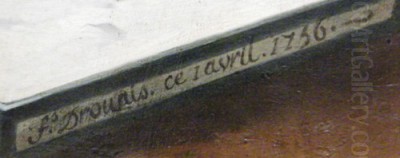
François-Hubert Drouais stands as one of the most accomplished and sought-after portrait painters of the French Rococo period. Active during the reign of Louis XV, he specialized in capturing the likenesses of the royal family, the aristocracy, and the wealthy elite of Paris. His work is characterized by its elegance, refinement, and meticulous attention to detail, offering a luminous window into the world of the French court in the decades preceding the Revolution. Born into an artistic dynasty, Drouais inherited a legacy of skill and connections that he skillfully leveraged to become a dominant figure in the Parisian art scene of his time.
Early Life and Artistic Formation
François-Hubert Drouais was born in Paris on December 14, 1727. Artistry was deeply ingrained in his family heritage. His grandfather, Jean Drouais, was a portrait painter, and his father, Hubert Drouais (1699–1767), was a highly respected and successful portraitist and miniaturist, known for his skillful work. It was under his father's tutelage that François-Hubert received his foundational training in drawing and painting. Growing up in this environment provided him not only with technical instruction but also with an early immersion into the world of artistic practice and patronage in the bustling capital.
Seeking to broaden his education, Drouais went on to study with other prominent artists of the day. He entered the workshops of Donat Nonnotte (1708–1785), a painter known for his portraits and historical scenes. He further honed his skills under the guidance of Charles-André van Loo (1705–1765), often known as Carle Van Loo, a towering figure in French painting who excelled in various genres, including history painting and portraiture, and served as Premier peintre du Roi (First Painter to the King).
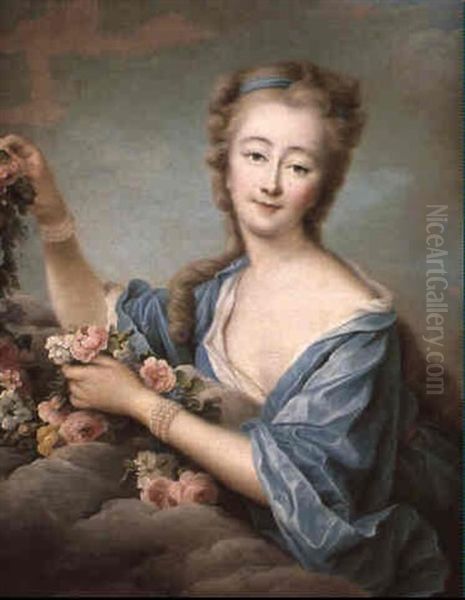
Perhaps most significantly, Drouais also studied with François Boucher (1703–1770), the quintessential Rococo artist whose sensuous mythological scenes, pastoral landscapes, and decorative designs defined the aesthetic of the era. Boucher's influence can be seen in Drouais's work, particularly in the delicate colour palettes, the graceful poses of his sitters, and the overall charm and lightness that pervade his canvases. However, Drouais would develop his own distinct style, often favouring a slightly more naturalistic approach, especially in his depictions of children. He also studied briefly with Charles-Joseph Natoire (1700-1777), another significant Rococo painter.
Rise to Prominence: The Académie and Early Success
Drouais's talent and connections paved the way for his official recognition within the French art establishment. In 1758, he was approved (agréé) and then received (reçu) as a full member of the prestigious Académie royale de peinture et de sculpture (Royal Academy of Painting and Sculpture). Membership in the Académie was crucial for any artist seeking high-level commissions and official patronage. His reception pieces were portraits of the celebrated sculptors Guillaume Coustou the Younger (1716-1777) and Edmé Bouchardon (1698–1762), demonstrating his skill in capturing the likeness and character of fellow artists.
From the mid-1750s onwards, Drouais regularly exhibited his works at the Paris Salon, the official art exhibition organized by the Académie. The Salon was the premier venue for artists to display their talents and attract clients. Drouais's submissions, primarily portraits, were generally well-received by critics and the public alike. His ability to render luxurious fabrics, intricate lace, and fashionable hairstyles with exquisite detail, combined with his flattering portrayals of his sitters, quickly made him a favourite among the Parisian elite.
His reputation grew steadily, and he began to receive commissions from increasingly important figures. His studio became a fashionable destination for those seeking a portrait that conveyed both status and charm. He succeeded his father not only in skill but also in navigating the complex social and artistic networks of Paris, establishing himself as a leading portraitist of his generation.
The Court Painter: Royal and Aristocratic Patronage
Drouais's success culminated in his appointment as one of the principal painters to King Louis XV and the royal court. He became particularly favoured for his portraits of the royal children and the influential women associated with the court. His clientele reads like a 'who's who' of the French aristocracy and high society during the mid-18th century.
He painted numerous portraits of the King's daughters, known as the Mesdames de France. He also captured the likenesses of Louis XV's grandchildren, including the young Louis-Auguste (the future Louis XVI), Louis-Stanislas-Xavier (the future Louis XVIII), and Charles-Philippe (the future Charles X), often depicted in charming, informal settings that highlighted their youth.
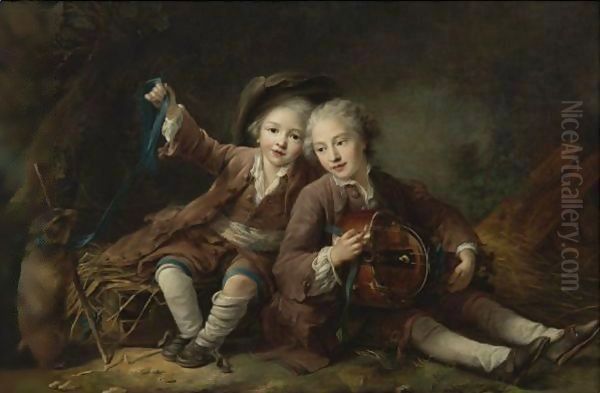
Drouais was notably commissioned by the two most famous mistresses of Louis XV. He painted several portraits of Madame de Pompadour (Jeanne Antoinette Poisson), the highly influential patron of the arts. One of his most famous works depicts her seated elegantly at her embroidery frame (Madame de Pompadour at her Tambour Frame, 1763-1764, National Gallery, London). He also painted her successor, Madame du Barry (Jeanne Bécu), capturing her beauty and allure in various poses and costumes, solidifying his position at the apex of court portraiture.
His royal commissions extended to the future queen, Marie Antoinette. He painted her as Dauphine upon her arrival in France, contributing to the visual representation of the Franco-Austrian alliance. These high-profile commissions cemented Drouais's status and ensured a steady stream of work from nobles and wealthy bourgeois eager to be immortalized by the same brush that painted royalty.
Signature Style: Rococo Elegance and Detail
François-Hubert Drouais's style is firmly rooted in the Rococo aesthetic, emphasizing grace, intimacy, and decorative beauty. His colour palette is typically light and airy, featuring soft pinks, blues, yellows, and creams, applied with a delicate touch. He masterfully handled light to create a gentle, flattering illumination on his sitters' faces, often highlighting their smooth complexions and bright eyes.
One of the hallmarks of Drouais's work is his extraordinary skill in rendering textures and materials. He depicted silks, satins, velvets, lace, and powdered hair with remarkable precision, capturing the shimmer of fabric and the intricate details of costume and accessories. This meticulous attention to detail not only showcased his technical virtuosity but also served to emphasize the wealth and status of his sitters, whose elaborate attire was a key marker of their social standing.
While influenced by Boucher's decorative sensibilities, Drouais often achieved a greater sense of naturalism and psychological presence in his portraits compared to some of his contemporaries like Jean-Marc Nattier (1685–1766), who frequently depicted his sitters in allegorical or mythological guise. Drouais generally preferred more straightforward, though highly idealized, representations. His compositions are elegant and balanced, often placing the sitter in refined interior settings or against subtle landscape backgrounds.
Drouais worked proficiently in both oil paint and pastel. Pastel portraiture was extremely fashionable in 18th-century France, with artists like Maurice Quentin de La Tour (1704–1788) and Jean-Baptiste Perronneau (1715–1783) reaching extraordinary heights in the medium. Drouais also demonstrated considerable skill with pastels, achieving soft textures and luminous effects suited to the intimate scale of the medium.
Master of Child Portraiture
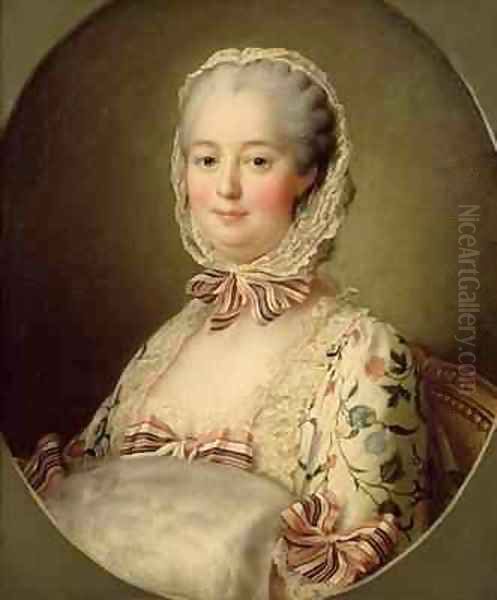
While adept at portraying adults, François-Hubert Drouais gained particular renown for his sensitive and charming depictions of children. In an era when child portraits often remained quite formal, Drouais excelled at capturing the innocence, spontaneity, and unique personality of his young sitters. He moved away from stiff, miniature-adult poses, often showing children engaged in play, interacting with pets, or holding toys.
His portraits of the royal children are prime examples of this talent. The double portrait The Comte d'Artois and his Sister, Madame Clotilde (1763, Louvre Museum, Paris) is one of his most celebrated works in this genre. It shows the young prince attempting to harness a goat while his sister looks on, capturing a moment of playful interaction with remarkable naturalness and charm. The children are dressed in elaborate costumes, yet their expressions and gestures feel authentic and unstudied.
Drouais seemed to possess a genuine empathy for his young subjects, allowing their personalities to shine through. He depicted their round faces, bright eyes, and soft features with tenderness. The settings often included elements associated with childhood, such as flowers, animals (dogs, cats, birds, goats), or simple toys, adding to the narrative and appeal of the images. This focus on the specific nature of childhood aligns him somewhat with contemporaries like Jean-Baptiste Greuze (1725–1805), although Greuze's depictions often carried a stronger moralizing or sentimental tone. Drouais's children remain firmly within the aristocratic sphere, presented with elegance even in their moments of play.
Notable Works and Commissions
Throughout his successful career, Drouais produced a significant body of work, much of which resides today in major museums like the Louvre, the Palace of Versailles, the National Gallery in London, and the Metropolitan Museum of Art in New York.
Besides the aforementioned Madame de Pompadour at her Tambour Frame and The Comte d'Artois and his Sister, Madame Clotilde, other key works illustrate his range and skill. Madame de Pompadour at Her Muff (c. 1760s) presents a more intimate view of the royal mistress. His portraits of Madame du Barry are also significant, including one where she is depicted en Flore (as Flora, the goddess of flowers), showcasing his ability to blend portraiture with subtle mythological allusion, a popular convention inherited from artists like Nattier. A portrait exhibited at the 1771 Salon, sometimes identified as Madame du Barry as a Vestal Virgin or simply depicting her in diaphanous robes, reportedly caused some controversy due to its perceived informality or intimacy, highlighting the fine line artists navigated in portraying powerful figures.
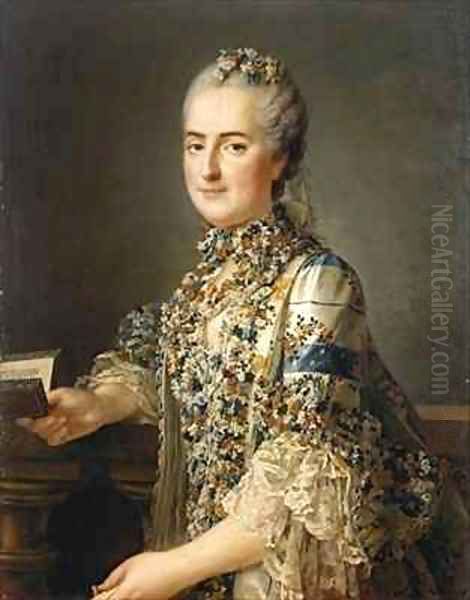
He painted numerous members of the extended royal family and the high nobility. Works such as Portrait of Louis XV (various versions exist), portraits of the King's daughters (Madame Adélaïde, Madame Victoire, etc.), and depictions of aristocratic children like the Marquis de Sourches and his Family or the Children of the Duc de Bouillon dressed as Montagnards further demonstrate his popularity among the elite. Each portrait aimed not just for likeness but for an image that conveyed grace, status, and adherence to the fashionable Rococo aesthetic.
Contemporaries and Artistic Milieu
François-Hubert Drouais operated within a vibrant and competitive artistic environment in mid-18th century Paris. His career overlapped with many significant painters. His teacher, François Boucher, remained a dominant force, influencing taste through his paintings, tapestry designs, and work for the stage. Jean-Marc Nattier was a chief rival in the field of court portraiture, particularly known for his allegorical portraits of the royal ladies.
Other notable portraitists included Louis-Michel van Loo (1707–1771), nephew of Drouais's teacher Carle Van Loo, who also enjoyed significant court patronage. Alexander Roslin (1718–1793), a Swedish painter working in Paris, was highly successful, known for his dazzling depictions of fabrics and society figures. In the realm of pastel, La Tour and Perronneau set formidable standards.
While Drouais perfected the Rococo portrait, the artistic winds were beginning to shift during the later part of his career. Jean-Baptiste Greuze gained popularity with his sentimental genre scenes and more emotionally charged portraits, hinting at a move towards greater naturalism and moral seriousness. Furthermore, the early stirrings of Neoclassicism were emerging, championed by artists like Joseph-Marie Vien (1716–1809), which would eventually supplant the Rococo style after Drouais's death. Drouais, however, remained committed to the elegant and refined style that had brought him fame and success throughout the reign of Louis XV.
Later Life and Legacy
François-Hubert Drouais enjoyed continued success and patronage until his death. He remained a favoured painter of the court and aristocracy, adapting slightly to changing fashions but largely maintaining his signature Rococo elegance. His career, though highly successful, was relatively short. He died in Paris on October 21, 1775, at the age of only forty-seven.
His artistic legacy was carried on, albeit in a dramatically different style, by his son, Jean-Germain Drouais (1763–1788). Jean-Germain showed immense promise and became a leading figure in the nascent Neoclassical movement. He was a favourite pupil of Jacques-Louis David (1748–1825), the standard-bearer of the new style. Tragically, Jean-Germain also died young, cutting short a brilliant career that represented a stark stylistic departure from his father's Rococo world.
François-Hubert Drouais's own influence persisted for a time, particularly in the realm of society portraiture. Artists like Antoine Vestier (1740–1824) continued aspects of his detailed and flattering approach. However, the French Revolution and the rise of Neoclassicism led to a decline in the appreciation of Rococo art, which came to be seen as frivolous and associated with the overthrown aristocracy.
Despite these shifts in taste, Drouais's reputation as a master portraitist has endured. His works are valued not only for their technical brilliance and aesthetic charm but also as invaluable historical documents. They provide a vivid and intimate glimpse into the personalities, fashions, and social rituals of the French elite during the final decades of the Ancien Régime. His ability to capture both the external likeness and a sense of the inner life of his sitters, particularly children, ensures his continued relevance and appeal.
Conclusion
François-Hubert Drouais was a consummate master of Rococo portraiture. Born into art and trained by the leading painters of his day, he rose to become the preferred painter of the French royal family and aristocracy during the reign of Louis XV. His canvases are celebrated for their delicate colour, exquisite rendering of detail, and graceful compositions. He excelled particularly in capturing the charm and innocence of children, setting a new standard for the genre. While his elegant style eventually gave way to the sterner aesthetic of Neoclassicism, Drouais's works remain captivating testaments to his skill and enduring records of a glittering, bygone era in French history. His portraits continue to enchant viewers with their refinement and offer a precious visual connection to the world of the Ancien Régime.